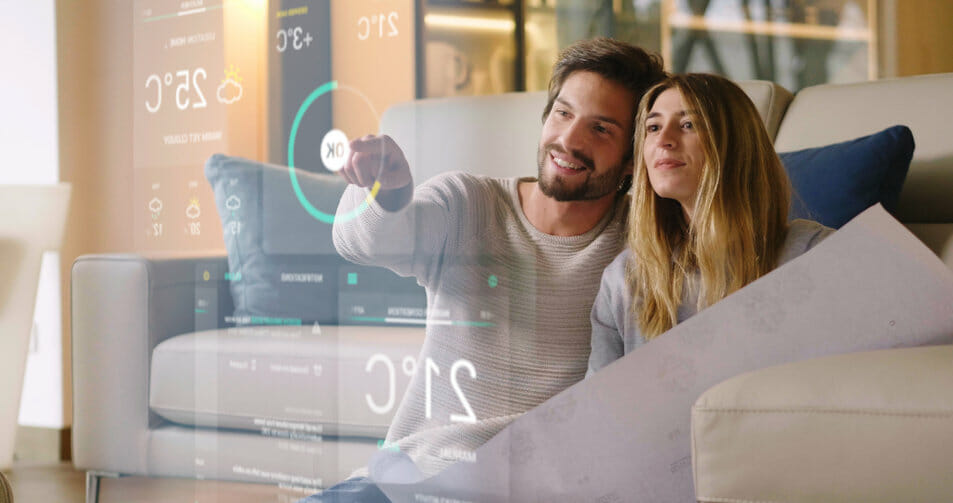Smart home technology can make life easier for renters. And renters want it.
Our Rent.com survey revealed that the majority of renters (82 percent) want at least one smart device or system in their home. Despite strong renter interest, nearly half (49 percent) of respondents don’t currently have smart home technology in their apartment, condo, house or townhome.
What is smart home technology?
Smart home technology refers to internet-connected devices in a living space. These devices automate, manage and monitor appliances and systems inside the house or apartment.
There are many smart home devices. Smart appliances can brew fresh coffee in the morning or suggest recipes based on what’s in the refrigerator. Smart lighting systems sense motion and daylight. Intuitive thermostats maximize energy efficiency and keep renters comfortable while they sleep. There are tech essentials for renters, devices for safety and security, even seasonal gadgets to make Christmas decorating easier and more fun.
A smart home refers to a series of smart devices that work together as a unit. They share data amongst themselves to streamline the home’s energy use, monitor the systems and customize the environment according to the residents’ preferences. The smart home controls the remote network.
You can build a smart home system into any type of dwelling. Since some features (like smart thermostats and wall outlets) are hard-wired, it can take additional time to retrofit older buildings.
Since installation requires time and money and residents must clear their sensitive personal information when they move out, some landlords and property owners have been slow to adapt to this new technology. There’s still a gap between the smart home technology that renters want and the devices they actually have in their homes.
The Rent.com survey
Rent.com researchers surveyed 1,546 people about their smart home technology preferences. We asked them which smart home features they currently have in their lease and which smart devices they wished they had. Renters also told us how much they’d be willing to pay every month for the smart home technology they wanted.
Then they ranked how important several smart devices were to them. Our survey addressed smart thermostats, smart lighting, smart outlets and smart appliances. We also asked renters for their opinions about security systems like smart locks/keyless entry systems and automated package lockers, as well as voice assistant controls like Alexa and Google Home.

Renter desire for smart home technology
The importance of smart home technology divided residents. Just over one-third of respondents (35 percent) said that smart devices were important or extremely important to them. A comparable number (36 percent) were neutral on the subject. Another 26 percent said they didn’t care or didn’t see smart home technology as important.
Most renters didn’t want a complete smart home system. Instead, the largest group of respondents (21 percent) told us they just wanted one device. Another 20 percent wanted two devices. An additional 16 percent wanted three smart home technologies and 10 percent would prefer four. A segment of renters (17 percent) didn’t want any smart devices at all.

The smart home technology renters currently have
Renter demand for smart home technology is only part of the equation. In order to better understand the devices renters want, it helps to look at the devices they already use.
Out of the 51 percent of respondents that do use smart devices, a fifth (21 percent) have just one device. Another 12 percent of renters have two devices, while 7 percent have three devices and 5 percent have four. Just over 2 percent of renters had five devices.
The most common smart home technology devices among those who own at least one were a voice control system — half of renters said they already had them — and smart appliances, which were in nearly 41 percent of rentals. There are several reasons why these devices are currently the most common.
Both voice control systems and smart appliances are marketed to consumers. They’re both relatively easy to set up and don’t need to operate as part of a larger smart home system. And only the largest appliances require complicated installation or a landlord’s permission, so renters can add these devices on their own.
The third most common device was smart lights (nearly 36 percent of renters have one), followed by smart thermostats and smart outlets, which garnered a 33 percent and 30.5 percent response rate respectively. Smart locks/keyless entry systems are used by slightly more than a quarter of current devices owners. And smart package lockers rounded out the bottom of the list, present in only 3 percent of rentals. Installing these systems is more complex, so the process is typically handled by professionals or overseen by the landlord.
locks/keyless entry systems

Usage in homes and apartments
People who rent houses are more likely to currently use smart home technology (56 percent) than apartment dwellers (49 percent). They also use specific devices at different rates.
More home renters (29 percent) told us that they had a voice control system than apartment residents (23 percent). There are smart appliances in 23 percent of rental homes and 20 percent of apartments. Another 21 percent of rental homes and 17 percent of apartments had intuitive lighting systems. Smart thermostats appeared in rental homes 21 percent of the time, compared to just 15 percent in apartments. The usage gap between rental homes and apartments narrows a bit with smart outlets (17 percent in houses and 15 percent in homes) and smart locks and/or keyless entry systems. The latter is found in 15 percent of homes and 12 percent of apartments.
An automated package system is the only smart home technology that apartment residents use more than people who rent houses. These lockers are in 8 percent of apartment households surveyed. Just 6 percent of home renters use a similar system.

The smart home technology renters want
Renters wanted a smart thermostat the most.
Thermostats also scored the highest importance ranking of any device on the survey when respondents were asked to rank the importance of each device on a scale from -2 to +2, where -2 is Don’t Care, -1 is Not Very Important, 0 is Neutral, 1 is Important, and 2 is Very Important. The average response for thermostats among all respondents is 0.39, between “Neutral” and “Important.”
But when we asked survey takers that wanted at least one smart device to rank the product, the average importance of thermostats increased to 0.81. That’s edging into “Important” territory. These respondents also ranked locks and package lockers similarly, at 0.77 and 0.73, respectively.
After smart thermostats, the smart home devices that renters most wanted were smart locks and/or a keyless entry system, followed by smart appliances and smart lights. Package lockers, a voice system and smart outlets came in at the end of the list.

Differences in the tech home and apartment residents want
Renters in homes and apartments wanted the most popular smart home devices (thermostats, lights and locks) fairly equally. For example, 46 percent of renters in houses and 45 percent of apartment residents wanted a smart thermostat. Another 45 percent of respondents in homes and 42 percent of survey takers in apartments wanted smart lights. Smart locks were a goal for 41 percent of house residents and 40 percent of apartment renters surveyed.
But apartment dwellers also want specific devices. They’re more likely (36 percent) to want a smart appliance than their counterparts in houses (31 percent). Renters in apartments also say they want a voice system more than house renters—22 percent versus 20 percent, respectively.
More apartment residents (23 percent) wanted a secure package locker than renters who lived in houses (16 percent). That’s the largest difference in the comparison portion of this survey.

Renters will pay more for smart devices
Renters understand that smart home technology costs money. And they’re willing to pay for it.
We asked renters to choose a dollar amount between $0 and $100 that they would be willing to pay for smart home technology every month. The average amount respondents were comfortable paying monthly is $37.65. Renters are also willing to pay slightly different rates for different devices, but the differences are minimal.
Of the renters who would pay extra, the first quartile would commit $10 a month for this expense, while the third quartile would be willing to pay $52.
Current rent prices also influenced the average price that renters were willing to pay for additional technology. Residents with rent payments under $500 a month indicated they’d pay the least ($35-$41 a month) in every category except one. These renters would commit an average of $47.45 for a secure storage locker. That’s more money than people with rent payments of $1,001-$2,000+ were willing to pay.
People paying between $501 and over $2,000 a month would spend an additional $40-$50 a month for most devices. They were only comfortable paying more than $50 a month for voice assistant systems and smart appliances. Although these groups of renters make very different rent payments, the amount they were willing to pay for each device was very similar.
There was a positive correlation between the price renters would pay for devices and the number of devices they wanted. Price increases quickly from no devices to one device, with renters willing to pay around $40, before slowly rising to a peak at $53 for five devices. After five devices prices stay flat even among renters who want six and seven devices.

Wising up to smart technology
The majority of renters want smart home technology in their homes, townhouses, condos and apartments. And they’re willing to pay more to get it. That’s welcome news for landlords who are considering adding smart home technology to their buildings and the next generation of renters who want these amenities. But landlords must also weigh the costs of additional devices with the potential gain in revenue. While adding one device may produce $40 in potential revenue, it would take four more devices to produce just $13 dollars in additional earnings.





